CELESTRON Ultima 100mm (4!) Weatherproof SPOTTING SCOPE
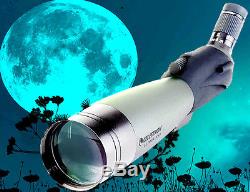
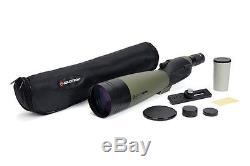
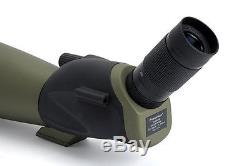
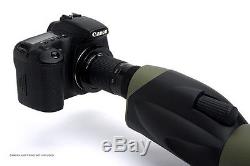
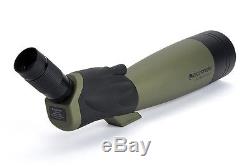
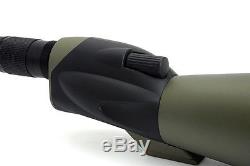

Celestron Ultima 100 Spotting Scope 100mm 45° Angle w/ 22-66x Zoom Eyepiece, 52252. Celestron Ultima 100 Spotting Scope-52252 made by Celestron is part of Ultima line of prismatic Spotting Scopes in 65mm, 80mm & 100mm varietins to suit your needs. Celestron Ultima spotting scope series was designed to perform well in a range of viewing situations, making it a great all-around optical instrument. Celestron Ultima-80ED Spotting Scope is a high performance model. Celestron Ultima 100 Spotting Scope-52252 has the largest aperture in the Ultima line. The image100mm Ultima #52252 offers more than 50% brighter images than the 80mm , allowing for better performance in low light conditions. Celestron Ultima 100 mm refractor features excellent multi-coated optics packed into a portable and durable refractor design and comes standard with a 22-66x zoom eyepiece. Ultima series was designed to perform well in a range of viewing situations, making it a great all-around optical instrument. You'll love Celestron Ultima-100 mm for observing nature and long distance spotting.
The green rubber optical tube allows for subtle observation in any nature environment. Ultima spotters are a great companion for any nature or outdoor enthusiast. For very long distance or very low light observing, nothing beats a very large aperture spotting scope for making distant or dim birds more visible. For large aperture value, nothing beats the 100mm aperture Celestron Ultima 100. For a price less than that of most 80mm scopes, this economical angled viewing 100mm scope makes a.
Aperture spotting scope affordable for just about everyone. Its large 100mm (4) objective lens gathers almost three times as much light as a 60mm scope, and over 56% more than an 80mm. The resolution is two-thirds higher than a 60mm scope and 25% higher than an 80mm, as well.
This extra brightness and resolution can give you the optical edge you need to make a positive ID in poor conditions, such as in the low light of early mornings or under heavily overcast winter skies, or when a bird is far away enough so that youre not even sure if its a bird at all. With such a large aperture, the scope is substantial in size and weight, but at only 4.5 lbs and a length of 19, it is not as much of a handful as you might imagine. Any good photo tripod should be sturdy enough to hold it with minimal vibration, but be prepared to upgrade if your existing tripod is a little on the shaky side. This is not a general purpose spotting scope, suitable for all applications. For the very long distance/very low light birder on a tight budget, however, the 100mm Ultima gives you more optical performance than you might ever have thought your budget would be able to afford. Compared to the cost of other 100mm spotting scopes, it is nothing short of a bargain. Optical features of this scope. 100mm objective lens gathers over 278% more light than a 60mm scope for superior low light performance. The crown and flint glass optics are multicoated for good light transmission.The standard equipment 22-66x multicoated zoom eyepiece has a soft rolldown rubber eyecup for eyeglass use. The eye relief is specified at a generous 18mm at 22x. While this is technically correct, the actual usable eye relief of this and all other spotting scopes typically measures a mm or two less due to the recessed location of the eyepiece. There will be some minor vignetting of the field for eyeglass wearers at 22x. The specifications to the right are for the zoom set at 22x.
At 66x, the field is 48 at 1000 yards. The scope close focuses down to 33. Through the scope, looking at a bird at that distance at 22x would effectively be the same as looking with your unaided eye from a distance of only 1 8. Mechanical features of this scope.
The scopes long focusing knob is located at the top right front of the prism housing to allow precise focusing with either hand, even while wearing gloves or mittens. It is semi-recessed to resist snagging on clothing or carrying case and is grooved for a sure grip.Focusing is quite brisk compared to most scopes, with less than five turns of the focus knob needed to move from one end of the focus range to the other. The Ultima 100s 45° viewing angle is generally more comfortable than a straight-through model for watching treetop activity or for extended observing from a blind or back porch. It is also more convenient for observing couples of widely differing heights who must share a single scope, as theres little need to constantly raise and lower the tripod to a comfortable height for each observer. If you are tall, you wont have to crouch over to see through the Ultima 100, as you would a straight-through scope. This can save you from the possibility of a literal pain in the neck.
A sighting tube built into the left side of the body allows fast centering of the scope on possible subjects. The scope mounts on any photo tripod having a standard 1/4-20 thread mounting bolt. A water-shedding stay-on soft case is standard equipment. The case has zippered fold-back flaps so you can use the scope on a tripod while it is still in the case.
The case has an adjustable length shoulder strap for carrying. A snap-in camera-type lens cover protects the objective lens. For photography, removing the soft rubber eyecup from the eyepiece exposes standard photographic T-threads. You can attach a 35mm camera body to the scope simply by threading an optional inexpensive T-ring onto the eyepiece and connecting your camera body to the T-ring.No separate camera adapter is needed. The scope becomes a 540mm telephoto lens with a fast f/5.4 focal ratio when you attach a camera. A spotting scope is a small telescope that has been modified for use by day.
A spotting scope differs from an astronomical telescope in several important ways. First, a spotting scope always produces an upright image whereas a telescope used in astronomy may produce a reversed image or even an upside down image (not a problem for astronomy). Second, a spotting scope is much smaller in size than an astronomical telescope, mainly for the sake of portability. Third, a spotting scope is a lower magnification instrument than a telescope, since the atmosphere by day does not allow the high magnifications used in astronomy.Fourth, a spotting scope is mounted on an ordinary photo tripod, but a telescope for astronomy requires a very specialized mount, often unsuitable for daytime use. Lastly, many, if not most, spotting scopes are waterproof and fogproof - a rare feature in an astronomical telescope. Spotting scopes are used anytime you need more magnification than a binocular provides. Spotting scopes are widely used for birding, surveillance, hunting, and viewing landscape, wildlife, ships and other distant objects.
Spotting scopes are also used for scoring targets on rifle, pistol and archery ranges and they can also be used to some astronomy. Last, but not least, spotting scopes are also used to take long distance pictures with a variety of cameras.Most spotting scopes are labeled with three numbers. The first two numbers represent the magnification range and the last number is always the size of the front lens.
For a 15-45x60 model, then, you have a spotting scope with a zoom magnification range of 15-45x with a front lens of 60mm diameter. Spotting scopes begin in magnification where conventional binoculars stop. The higher magnifications offered by a spotting scope allow you to view birds, wildlife, scenery and other objects that are well beyond the range of a conventional binocular. However, there are limits to magnification. Two things determine how much magnification you can use in a spotting scope. The first is the atmosphere. You must always factor in the seeing conditions of the atmosphere when using a spotting scope. Heat waves, dust, humidity, glare, wind and air currents during the day all reduce image quality and the greater the magnification, the more drastic the reduction in image quality.Simply put, there will be days when anything over 30x will appear as mush, but there will also be those clear, calm days when you can use 60x to good advantage. In general, high altitudes and dry climates favor high magnification whereas wet, humid, low-altitude climates discourage high magnification.
Very few locations, however, allow you to use more than 60-80x during the day, so most spotting scopes stop at 60x. The atmosphere, for the same r eason, also limits how much detail you can see at great distances.
Seeing tiny detail, such as a person's facial features, at a mile or more through an ocean of turbulent, ever-moving air is simply not possible, no matter how much magnification you use or no matter how large or expensive the instrument. Spotting scopes are great, but they can't work miracles. On the other hand, it is quite possible to view large objects such as ships at this distance, though the image may be blurry or wavy. The second major limit on magnification is the optical system of the spotting scope, itself.
Regardless of the model, there will always be some drop off in image quality as magnification goes up. This is determined somewhat on the design and size of the scope, but primarily on the quality of the optical system. Here you get what you pay for in a very visible way. Inexpensive spotting scopes, regardless of size or type, lose image quality quickly as magnification goes up, but premium grade scopes lose very little in image quality, even at the highest magnification.
Be prepared to pay, however, if you want a spotting scope that is as sharp at 60x as it is at 20x. Only a handful of very expensive spotting scopes are capable of this. Most observing with a spotting scope, though, is done at lower magnifications, usually around 30x-40x. This is more than enough for most applications and all but the cheapest model will produce reasonable images in this magnification range.
Comet Hale-Bopp in 1997 using a 35mm film camera on a tripod. This is a raw image with NO image processing used. Sunrise on the Independence Day by scibuff. The item "CELESTRON Ultima 100mm (4!) Weatherproof SPOTTING SCOPE" is in sale since Tuesday, July 21, 2015.
This item is in the category "Sporting Goods\Hunting\Scopes, Optics & Lasers\Spotting Scopes". The seller is "bluequasar17" and is located in Pewaukee, Wisconsin. This item can be shipped worldwide.
- Type: Spotting Scope
- Max Magnification: 60x
- Use: Bird Watching
- Features: Image Stability
- Brand: Celestron
- Model: Ultima 100
- MPN: ASCSN52252
- Body Type: Angled
- Coating: Multi-Coated
- Eyepiece Type: Zoom Eyepiece
- Waterproof: With Waterproof

